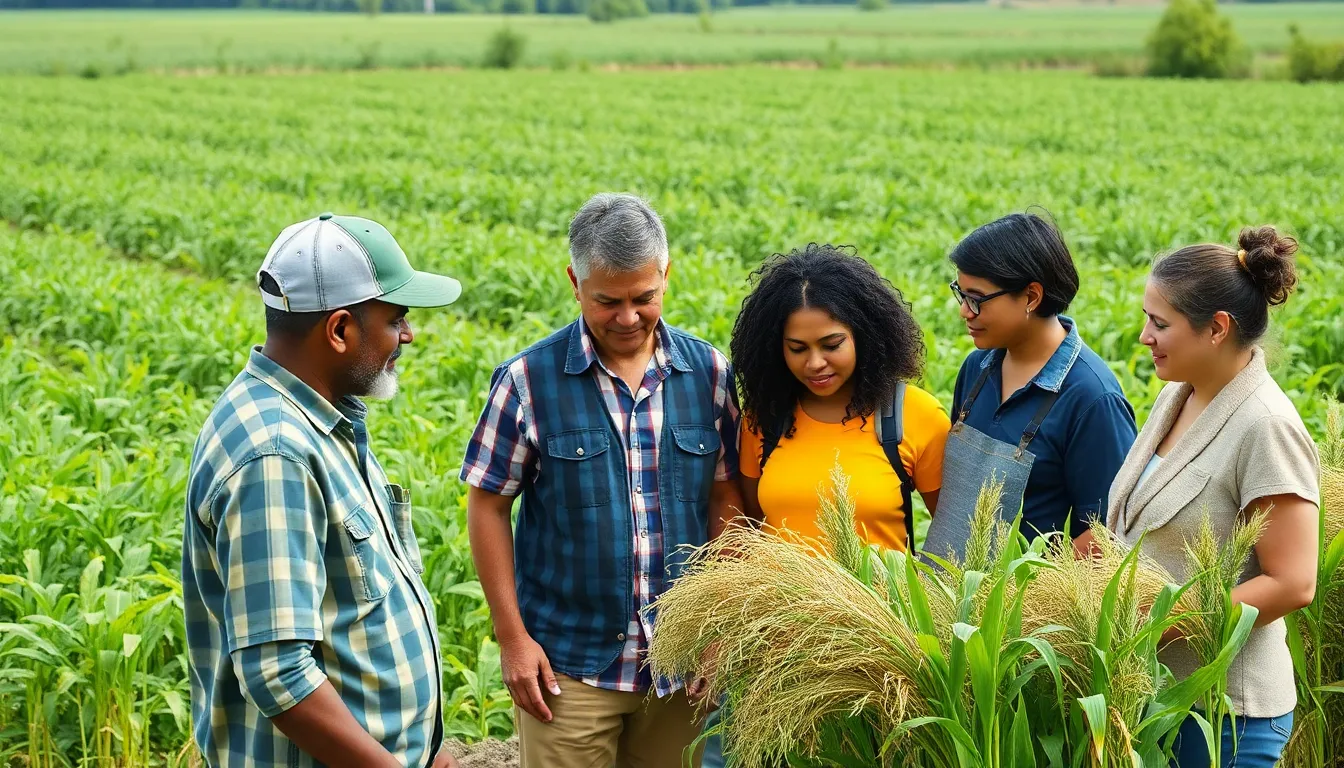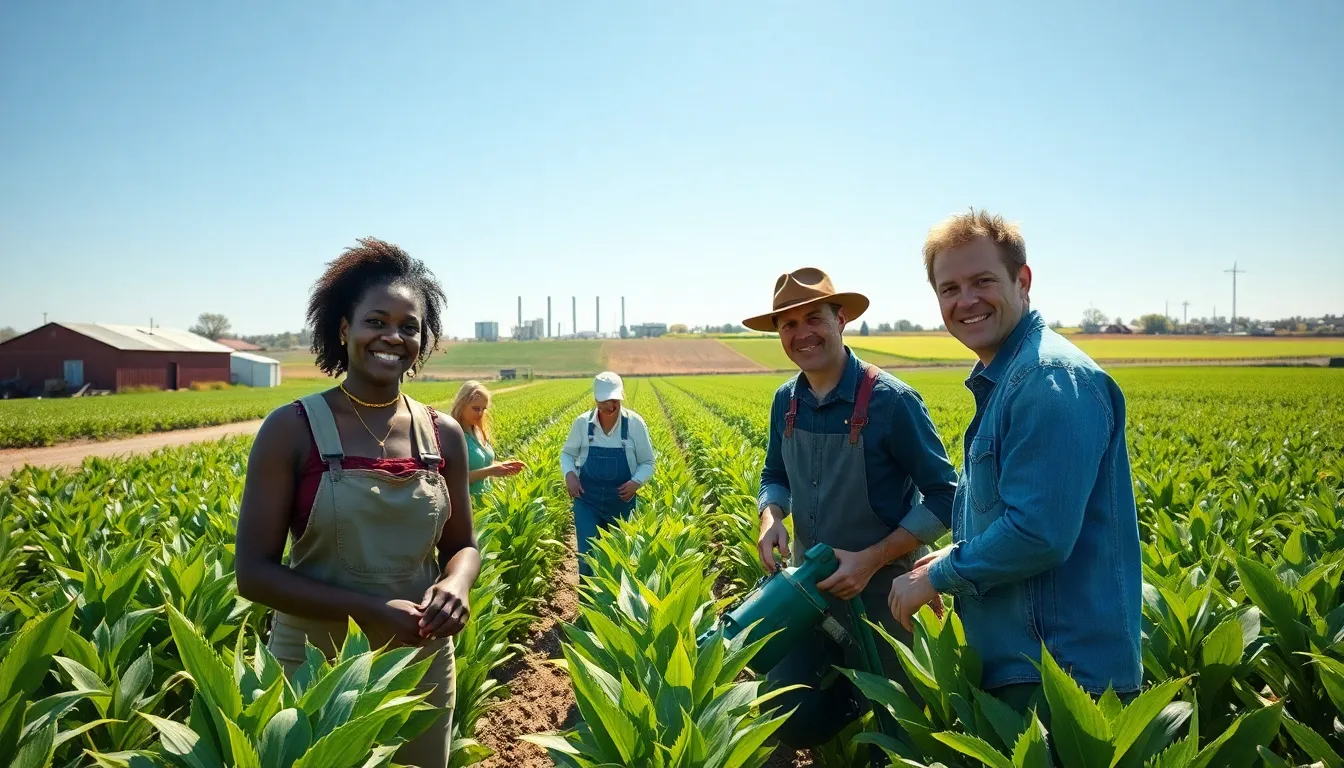In a world increasingly focused on sustainable solutions, bioenergy stands out as a promising alternative to fossil fuels. Harnessing energy from organic materials, it offers a renewable resource that can power homes, businesses, and vehicles while reducing greenhouse gas emissions. As concerns about climate change and energy security grow, bioenergy presents an opportunity to transition towards a greener future.
From agricultural waste to dedicated energy crops, the sources of bioenergy are diverse and abundant. This versatility not only helps in minimizing waste but also supports local economies by creating jobs in the renewable energy sector. As technology advances, the potential of bioenergy continues to expand, making it a vital player in the global energy landscape. Understanding its benefits and challenges is essential for anyone interested in the future of energy and environmental sustainability.
Table of Contents
ToggleWhat Is Bioenergy?
Bioenergy refers to the energy derived from organic materials, known as biomass. It serves as a renewable alternative to fossil fuels, playing a vital role in addressing climate change and energy needs.
Definition and Overview
Bioenergy encompasses energy produced from biological materials, providing an effective way to convert waste into valuable resources. It includes methods to generate power, heat, and biofuels, contributing to reduced greenhouse gas emissions. Biomass sources consist of plant and animal materials that can be converted through chemical, thermal, or biological processes. This approach not only supports energy security but also fosters sustainable practices in energy production.
Types of Bioenergy
Biomass can be categorized into several types, each with distinct applications:
- Biogas:
- Biogas emerges from the anaerobic digestion of organic waste.
- Applications include heating, electricity generation, and transportation fuel.
- Biofuels:
- Biofuels, such as ethanol and biodiesel, derive from crops and waste oils.
- They serve as renewable fuel alternatives for vehicles and machinery.
- Solid Biomass:
- Solid biomass includes wood, agricultural residues, and dedicated energy crops.
- Uses range from direct combustion for heat to conversion into gas or liquids.
- Biomass Pellets:
- Biomass pellets compact organic material for improved storage and transportation.
- They are commonly used in biomass heating systems and power plants.
- Algal Bioenergy:
- Algal bioenergy utilizes algae for fuel production.
- Algae can produce high yields and be cultivated on non-arable land.
Each type of bioenergy harnesses organic matter, enhancing energy diversity while supporting environmental sustainability.
Benefits of Bioenergy

Bioenergy offers multiple advantages, from environmental benefits to economic growth. Its potential as a sustainable energy source positions it as a crucial element in the fight against climate change.
Environmental Impact
Bioenergy significantly reduces greenhouse gas emissions. It contributes to lower levels of carbon dioxide compared to fossil fuels, as plants absorb CO2 during their growth. Bioenergy’s usage helps in the recycling of organic waste, which minimizes landfill contributions and decreases methane emissions. Additionally, bioenergy production promotes biodiversity by leveraging agricultural residues and other biological materials, ensuring that ecosystems receive less pressure from resource extraction. The cultivation of dedicated energy crops can also enhance soil health through improved crop rotation practices.
Economic Advantages
Bioenergy creates job opportunities across the supply chain. It supports farming, processing, and distribution sectors, fostering growth in rural communities. According to the International Renewable Energy Agency, the bioenergy sector employs over 3 million people worldwide. Bioenergy helps stabilize energy prices by diversifying energy sources, thus reducing dependence on volatile fossil fuel markets. Investing in bioenergy technologies also drives innovation, attracting funding for research and development initiatives, ultimately enhancing the overall resilience of energy systems.
Challenges and Limitations
Bioenergy faces several challenges and limitations that can impede its growth and adoption. These challenges range from land use conflicts to technological constraints.
Land Use and Competition
Land use for bioenergy production can conflict with food production, leading to increased food prices and food insecurity. Agricultural land often requires significant resources for bioenergy crops, reducing the availability of acreage for food crops. For example, using corn for ethanol production can drive up the price of corn, directly affecting food markets. Additionally, converting forests or grasslands into bioenergy plantations poses threats to biodiversity and ecosystem stability. Balancing land allocation between food, fuel, and conservation remains a significant hurdle for sustainable bioenergy development.
Technological Barriers
Technological barriers restrict the efficiency and scalability of bioenergy solutions. Current conversion technologies, such as anaerobic digestion and fermentation, often require extensive capital investments and expertise. Furthermore, the efficiency of biomass conversion varies widely among different feedstocks and processes. For instance, second-generation biofuels derived from lignocellulosic biomass remain less economically viable compared to first-generation options. Advancing technologies is crucial for improving yields and reducing costs. Without these improvements, bioenergy cannot achieve its full potential as a reliable energy source within the renewable energy portfolio.
Current Trends in Bioenergy
Bioenergy is evolving rapidly, driven by advances in technology and increasing global demand for renewable energy sources. Key trends include innovations in production processes and rising adoption rates across various regions.
Innovations in Production
Innovations in bioenergy production focus on enhancing efficiency and expanding feedstock options.
- Advanced conversion technologies improve biomass conversion, increasing overall energy yield while minimizing waste. Processes such as gasification and pyrolysis enable the transformation of various organic materials into high-quality biofuels.
- Research into algae-based biofuels showcases potential for high yield and versatility. Algae can be cultivated in diverse conditions, reducing competition for arable land.
- Integration of circular economy principles facilitates waste utilization. Organic waste from agriculture and industry is repurposed, creating energy while reducing landfill waste.
- Technological advancements in biogas production enhance methane capture from organic waste. Improved anaerobic digestion techniques increase biogas output, making it a more viable energy solution.
Global Adoption Rates
Global adoption rates of bioenergy reflect a shift towards sustainable energy solutions.
| Region | Bioenergy Share (%) | Year of Data |
|---|---|---|
| Europe | 10.5 | 2020 |
| North America | 6.4 | 2020 |
| Asia-Pacific | 8.2 | 2021 |
| Latin America | 3.5 | 2020 |
| Africa | 2.0 | 2021 |
- Europe leads in bioenergy utilization, with policies promoting sustainable practices and significant investments in infrastructure.
- North America sees growth, especially in biofuels for transportation. The U.S. aims to increase biofuel blending into gasoline and diesel.
- Asia-Pacific regions also adopt bioenergy solutions, driven by energy consumption increases and environmental policies. China and India focus on biomass power plants and biogas production.
- Latin America experiences moderate growth, with many countries utilizing agricultural waste for energy. Brazil is a notable player in bioethanol production from sugarcane.
- Africa faces challenges related to infrastructure but shows potential for decentralized bioenergy systems, particularly for rural electrification.
Overall, the increasing focus on bioenergy indicates its central role in achieving sustainability goals and transitioning to renewable energy.
Future of Bioenergy
The future of bioenergy hinges on supportive policies, innovative research, and new technologies. Enhanced efforts in these areas will significantly shape the growth trajectory of this renewable energy sector.
Policy and Regulation
Policies and regulations play a critical role in advancing bioenergy adoption. Governments worldwide are establishing frameworks that incentivize bioenergy production through subsidies, tax breaks, and renewable energy targets. For example, the Renewable Fuel Standard in the United States mandates the blending of biofuels into transportation fuels, driving demand for bioenergy solutions. Additionally, the EU’s Renewable Energy Directive sets binding targets for renewable energy usage, boosting investments in bioenergy technologies. Effective regulations addressing sustainability criteria ensure responsible biomass sourcing, minimizing negative impacts on food production and biodiversity. Integrating these measures will bolster investment confidence and facilitate the transition to a more sustainable energy system.
Research and Development Directions
Research and development (R&D) remains key to unlocking the full potential of bioenergy. Innovative technologies focus on increasing biomass conversion efficiencies and enhancing feedstock varieties. One significant area of R&D involves advanced pretreatment processes that break down complex biomaterials, making it easier to convert them into biofuels. Another promising direction includes genetic engineering of energy crops to optimize yields and resilience against pests or climate stressors. Investments in bioreactor technologies improve algal biofuel production, presenting new avenues for renewable energy. Collaboration between public and private sectors fosters a culture of innovation, supporting a thriving bioenergy ecosystem poised for future growth.
Bioenergy stands as a pivotal player in the quest for sustainable energy solutions. Its ability to convert organic materials into renewable energy not only addresses climate change but also fosters economic growth and job creation. As advancements in technology continue to emerge the potential for bioenergy to contribute to a cleaner and more resilient energy landscape becomes increasingly evident.
However the challenges it faces require careful navigation. By prioritizing innovative research and supportive policies stakeholders can unlock bioenergy’s full potential. The collaborative efforts of public and private sectors will be essential in overcoming barriers and maximizing the benefits of this renewable resource. As the world moves toward a greener future bioenergy’s role will only grow more significant.





